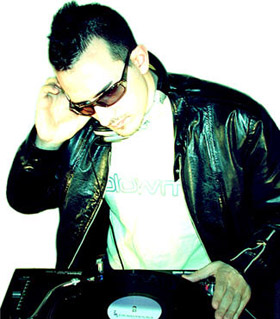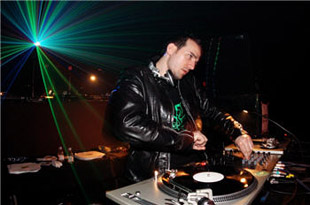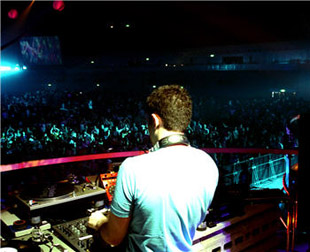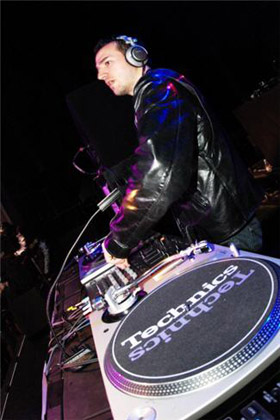CN Interview: DJ Hatiras
Born in Canada, Hatiras developed a passion for music at a very early age, making and selling his very first mix tapes by the age of 12. His intense passion for music, which derives from drum and bass, techno, funk, disco and house, has inspired the production of his funk-filled, energetically engineered tracks.
While he has received significant attention recently, Hatiras is no stranger to the electronic music world. In 1993, Hatiras along with two close friends, established a concert promotions company called Liquid Adrenaline, which steadily grew to become one of the largest in North America. Their events attracted as many as 10,000 partygoers from America and Canada and featured some of the leading names in dance music. It was through this channel that Hatiras fine-tuned his musical talents and formed relationships with many of the key players in the business.

His career later took off when he joined forces with music industry powerhouses Bad Boy Bill and Michael Ryden of Chicago-based label Mix Connection Multimedia. Their first collaboration was released on Mix Connection subsidiary, International House Records (IHR), and was an instant success. The atomic blast of Hatiras’ creation, “Liquid Adrenaline Sessions 1,” vaporized the borders of music and technology and included the hit track “Digital Doom,” which generated substantial recognition for Hatiras.
His subsequent releases were just as powerful, but it wasn’t until the release of his chart-topping global smash single, “Spaced Invader,” that the world got to know Hatiras. The song earned Hatiras a Canadian Juno Award (the equivalent of an American Grammy) for “Best Dance Recording” in 2002. Revered for his driving beats and stunning grooves, Hatiras’ unique style has put him in high demand on the remix circuit, where he has remixed artists such as Kylie Minogue and many others on labels such as Sony and Universal Music, just to name a few.
In 2003, Hatiras formed his own record label, Blow Media, in which he continues to release his music, as well as focusing on nurturing other promising artists. Blow Media has seen tremendous acceptance, growth and success with a string of consistent hits including, “Money Shot,” “Hot Box,” “Love For The Weekend,” “Baked From Scratch” and “Spanish Fly,” a collaboration with Macca which earned Hatiras his second Juno Award in 2006. The label continues to shine with Hatiras’ successful “Electronic Luv” compilations and smashing releases by other talented producers/DJs, such as Antoine Clamaran, Robbie Rivera, DJ Dan, Jaxon and Macca.
He has traveled the world and sold hundreds of thousands of records over the course of his music career, earning the distinction as one of the most influential electronic music producers and DJs in the world today. During the course of our interview, Hatiras opens up about his past, the many experiences of his life, how technology is changing the music industry, and the future of electronic music.
CN: You lived a very interesting childhood. Did you always know that you wanted to be in the entertainment industry?
Hatiras: I grew up mainly in Toronto, but also lived in South Africa, Greece and Switzerland for a few years. Those travels opened my mind to the fact that the world is a big place. I never intended to be in the music industry. When I was a little child, I wanted to be a clown. My parents encouraged me to follow my dreams as long as I tried my best.
CN: Were you always into music growing up? Who were some of your influences?
Hatiras: Definitely. My interest in music was sparked by early Michael Jackson, Wham!, Madonna, Lionel Ritchie, etc. From there, I discovered electronic-type music, like Depeche Mode, New Order and Information Society. I was also a huge fan of freestyle/’80s from guys like Stevie B, Trinere and Sweet Sensation. I guess that growing up, I was always into dance music the most. I was also influenced by my older sister who gave me my first DJ tapes that were mixed by her older skater friends.

CN: So when did you first start DJing and producing?
Hatiras: I used to put together and sell mix tapes with my old school double tape deck at the age of 12. They were cut-ups of songs from my favorite underground dance radio shows. In my late teens, I dabbled with turntables and vinyl. My first record was released in 1998, and by the next year, I was touring as a DJ. However, before all that I was throwing massive raves in Toronto and Minneapolis. I’ve done event promoting, MCing, DJing, radio, production, design, management and more. You could say I’ve worn every hat in this business.
CN: What’s your process like when you head into the studio to make music?
Hatiras: My biggest limitation is time, due to all of my traveling. When I do decide to make music, I go on a creative blitz. Everything in my studio has to be clean, organized and clutter free. I’ll get into a relaxed state and then mess around with the gear and software. The process usually starts with excitement, then depression, and finally it ends with euphoria when I finally nail an idea that’s dope. It’s a truly strange ride that has really torturous and manic moments, as well as ridiculously high points. It’s weird because I tap into the logical part of my brain to work the equipment, but connect to the irrational side to get creative.
CN: “Spaced Invader” obviously was an enormous success for you. Did you have any idea that you were on to something big?
Hatiras: I knew I was onto something big on an underground/ravey kind of level, but never imagined that the tune would break into the pop-world. It was aired on radio stations in pretty much every country on the planet. We also filmed a music video and I did a whole bunch of TV, radio and press. It was kinda fun seeing myself in all the European music magazines, but I took it all in stride and remained humble. Overall, the experiences that ‘Spaced Invader’ gave me taught me a lot about the music business (both good and bad).
CN: You’ve worked with a lot of different artists over the years — people like Jaxon, Macca, Bad Boy Bill and DJ Dan. What do you pick up from each artist and how do those collaborations help you?
Hatiras: All of those guys are good friends. They’re all unique in their own way and really great. Jaxon is one of the most talented musicians I know — and he’s an absolutely insane performer. Macca is one of the most technically skilled and detail-oriented guys I know. Bad Boy Bill is a true entrepreneur. Dan is a straight-up, down-to-earth guy who exemplifies the notion that good guys can finish first. There’s definitely something to learn from all of them.
CN: Is there anyone in particular that you’d love to work with in the future?
Hatiras: I don’t know where to begin… Hmm. It would be cool to work with really high-end singers like Madonna or members of Depeche Mode. I would probably relate to guys like Daft Punk or the Swedish Mafia in the studio — everything they do is great. It might also be fun to work with some gangster rappers. How about 50 Cent on a house tune? It would be a dream to have a team of brilliant engineers and musicians following my command!
CN: How has electronic music changed over the years and what do you predict for the future?
Hatiras: I feel that electronic music has really matured to a point now where the musicality, quality and use of technology in the productions has never been better. There will always be a lot of bad songs out there, but some of the good ones are really outstanding. You’ll always have to pick the great tunes out from the pack of filler.
CN: Obviously electronic music is huge overseas. How do you rate the scene in the U.S. and how would you make it better?
Hatiras: The scene in the U.S. is held down by lack of media/radio/TV support. However, a lot of people do follow the music in their homes and in the clubs. It’s gonna take some publicity and some fresh approaches to blow it up here. I feel that it’s only a matter of time until that happens. Things will change dramatically when the Internet finally overtakes television. The Internet gives people the freedom to support what they like, as opposed to being force-fed what the mainstream media is pushing — the future is exciting.

CN: Speaking of the Internet, what are your thoughts on the impact the Web has had on the music industry?
Hatiras: So far it’s been a double-edged sword. On one hand, the net has facilitated mass music piracy, but on the other, it’s leveled the playing field so that artists could connect directly to fans without a major label or heavy expenses. It’s still sorting itself out, but I’m confident that in the coming years the music industry is going to boom because of the power and reach of the Internet.
CN: In addition to the Internet, satellite radio has also changed the music scene. In your eyes, how has satellite radio impacted electronic music?
Hatiras: It’s quite brilliant really. Before satellite, radio people were limited to the few songs rotated on the handful of radio stations in their city. Satellite radio gives people the choice to listen to what they want, when they want. That’s huge for the progress of all kinds of different music.
CN: Is it important that electronic music keeps an underground feel and doesn’t go overly mainstream?
Hatiras: A lot of people confuse the term ‘mainstream’ with selling out or cheesing out. As long as the music isn’t compromised or watered down, then I have no problem with the notion that more people would be exposed to it and have the opportunity to enjoy it. With that said, I personally make some songs strictly to innovate and experiment, and others to move a crowd and make people smile. It’s important to have every kind of music; they all have their place.
CN: Do you have preference when you DJ as it relates to using either vinyl, CD or digital?
Hatiras: I used to be a strict vinyl supporter. However, I’m all about CD right now. I’m a little paranoid about bringing a nice laptop to a club that might get stepped on or have beer spilled on it. The beauty of CD is that I can make a song on the airplane, burn it, and then test it out in a club. CD also allows me to make edits of tracks, shorten the boring parts, and create more dynamic, exciting sets. It’s also quite durable, light and transport friendly. I’m completely opposed to the concept of downloading music illegally. However, as long as a DJ is purchasing their digital music, being creative and working the crowd, then they’re doing their job. It’s all about stage presence, selection, flow and performance — some people do that with vinyl, others do it with CDs, others with a guitar, a mic or a flute — take your pick. The main thing is that the artist challenges himself and the crowd while still pleasing the room.
CN: So would you say there is a definite place for vinyl in the future?
Hatiras: Absolutely. Some DJs will completely make their careers through the novelty and challenge of playing vinyl. It will continue to shrink as a market, but there will always be a niche for it.
CN: Along with Peter Weingarden, you formed and operated the promotion venture Liquid Adrenaline from 1993-2001. How did you and Peter get started?
Hatiras: I met Peter in junior high school. We became great friends early on and have gone on many adventures together, including forming and organizing the massive Liquid Adrenaline raves with our third partner, Craig.
CN: Liquid Adrenaline proved to be an enormous success.
Hatiras: When I discovered Toronto’s rave scene in the early ’90s, I was instantly hooked. It wasn’t long before I started a ‘smart bar’ with my friend, Craig. We called it Liquid Adrenaline. It was basically a juice bar where we sold shakes that contained fruit, vitamins, protein powders, etc. Within a few months we were running our booth at multiple rave events per week. People really got to know about the booth, so we decided to throw an event in 1995. We rented the basement hall of a church and snuck people in through the back alley entrance. About 700 people showed up. From there, we went full steam ahead and ended up throwing over 40 events in warehouses, airplane hangars, convention centers, cruise boats, hotel suites, etc. By the end, we were attracting 5,000+ steady, with upwards of 10,000 at some of our shows. It grew into one of North America’s largest event promotion companies. By 2001, the intense negative media pressure and political obstacles led us to finally stop. I could write a really unbelievable novel with all of my experiences from those days!

CN: Along with Peter, you launched Blow Media in 2003. What led to your decision to start your own label?
Hatiras: By 2002, illegal music downloading was rampant in the industry. That caused a lot of labels to suffer and shut down. I could have quit the industry at that time, but instead found an opportunity to build a label that would be ready for the shift from hard product to digital music. I also wanted to build an outlet to release my own music and to nurture other new artists as well.
CN: What were some of the goals that you had in mind for the label?
Hatiras: So far a lot of my goals have been met. We have worldwide distribution, which means that Blow Media music is instantly available on over 200+ download shops around the world. We’ve also got a lot of solid artists producing material. From here, I’d like to get some more artists on board, and hopefully get some massive hits under our belt. Then we can expand into a greater radio and TV presence and start organizing events and more worldwide tours. I’d love to see the label become a household name for music lovers. With that said, I plan to keep the punk mentality that the label is based on — if people don’t like the music they can blow me — I’m not doing this to follow, but to innovate, open minds and open doors.
CN: Is there a particular type of artist that you look for?
Hatiras: I’m looking for complete producers — artists who can make music from start to finish and provide a professional sound with an inspired, creative idea. I’m always looking for vocalists and musicians as well. Basically, people that have a vision for quality and perseverance, and a sound and image that vibes with Blow Media.
CN: You have a ton of great artists with Blow Media already. Who should people be looking out for?
Hatiras: There’s so many… Of course, keep an eye out for my new material and music from Da Skunk, Hirshee, Ortzy, Chris Kaeser, Jeff Daniels, Mario Ochoa, Kid Massive, Messinian, Flipside and more. We get tons of demos from newcomers every day. Hopefully some of these new guys can break through as well. Also, keep an eye out for some of big names to be featured as remixers on some of the classic Blow Media tunes.
CN: How do you differentiate the music on Blow Media from the rest of the pack?
Hatiras: The music on Blow Media is pretty diverse, but a lot of it is funky, peak hour, fun, electro-house madness. It also has a distinct feeling of tension, danceability and pumpiness.
CN: Besides the artists with Blow Media, who are some others in the electronic industry today that you admire?
Hatiras: I don’t know where to start… I probably admire Daft Punk the most for the way they created a new sound and spread it around the world. Their musicality, production, marketing and quality is still on top. Bob Sinclar is also doing a great job. Dirty South is producing fantastic music. Axwell is consistently great. There are so many guys doing good things now.
CN: I understand that you are working on a new album. When will it be out and what can we expect?
Hatiras: I’m working on material for my next album right now. I’m thinking maybe the fall… It should be pretty bumpin’ and diverse with influences from electro, techno, Latin, drum and bass, disco, etc. It’ll definitely be fun and up-tempo with a few twists. I’m also looking to feature some vocalists that I’ve worked with in the past, as well as some new ones.
CN: I know that you’re been touring like crazy. What do you have planned for the future?
Hatiras: I just got back from a mad amount of touring with shows in Germany, Czech Republic, Colombia, U.S., Canada, etc. I’m slowing it down a bit through June to work on new music, but will still be performing in cities closer to home such as Syracuse, Hamilton, Toronto, and some stops in both Canada’s east coast (New Brunswick) and west coast (Vancouver, Victoria, etc.).

CN: You’ve been in the business for many years now. How much more challenging is the travel as you grow older?
Hatiras: It’s probably a little more challenging now, because I have so many things to do, and so little time. I’ve found that using my laptop on flights has been a real help. The thing about touring is that it gets really hard on the body, due to a messed up sleep schedule, inconsistent eating, stress, etc. But it’s all worth it in the end.
CN: In the midst of your already hectic life, I see that you still managed to add a weekly radio show to your schedule.
Hatiras: I produce and host a weekly radio show called Blow Media radio. It airs on Energy 105.1 FM in Toronto and on a variety of online stations around the world. I feature a different guest mix every week (as well as my own mixes of course). It’s basically a show that aims to spread the vibe on house/electro, etc. and educate people on the artists that actually contribute to the scene.
CN: Dare I ask…is there anything else that you’d like to do in the future?
Hatiras: Tons. Make more music, try producing different styles, one day having a family and kids, scoring music for films, getting into the movie industry on some Indie capacity, sleeping more!
CN: What sort of changes can you foresee for electronic music in the future? Do you think producers will draw from any particular genres?
Hatiras: I think that with increasingly better home studio technology, more and more bedroom producers will become successful. Electronic music will also draw from more styles of music, and will get more musically grounded and song-based. I’m also predicting a trend starting soon where influences are drawn from early ’90s hardcore, early drum and bass, early Prodigy/Acen sounds, and more MC-style vocals.
CN: You obviously have tons of experience to draw from. Is there any advice that you would lend to aspiring DJs and producers hoping to walk in your shoes some day?
Hatiras: Try not to get overwhelmed and keep learning. Never get arrogant over any successes, instead, keep looking forward. Also, there should be a lesson from every production and experience you go through.
CN: With all the places that you’ve traveled, not to mention working the rave scene for many years, I’m sure you must have quite a few wild stories in your back pocket.
Hatiras: I don’t know where to begin! I’ve seen a lot. One of the memories that comes to mind was a party I threw in Toronto back in 1996. It was called ‘Time Warp.’ We rented a Karaoke hall above a grocer in China Town and rammed 1,200 people into the place. The crowd was going off so hard that the floor was doing the wave. By 1 am, the cops came in and shut us down for exceeding capacity. After dealing with that headache, I quickly bolted down to another club called Oz, paid the owner a mad amount of cash, and directed over a thousand crazy ravers on a chanting march down the streets of Toronto to the new venue. It was an extremely stressful and exciting experience. At the end of the day, the party was a success and everybody was happy, but I’m pretty sure that it gave me my first gray hair!
CN: How have you changed over the years? Is it safe to say that you’re older and wiser now?
Hatiras: Absolutely. I have a much clearer understanding of the music business (and life) now that I’ve been through some ups and downs.
CN: How do you react when people refer to you as one of the most influential contributors to electronic music over the years?
Hatiras: That’s a flattering statement. Don’t make me blush.
CN: So when you look back now with all of those years of wisdom, is there anything that you would do differently if given the chance?
Hatiras: Not necessarily. There’s a reason for the negative experiences in my life that have also led me to where I am now. I’d rather look to what I can do in the future, instead of lamenting on the past.
Recommend0 recommendationsPublished in Celebrity, Features, Music



Responses